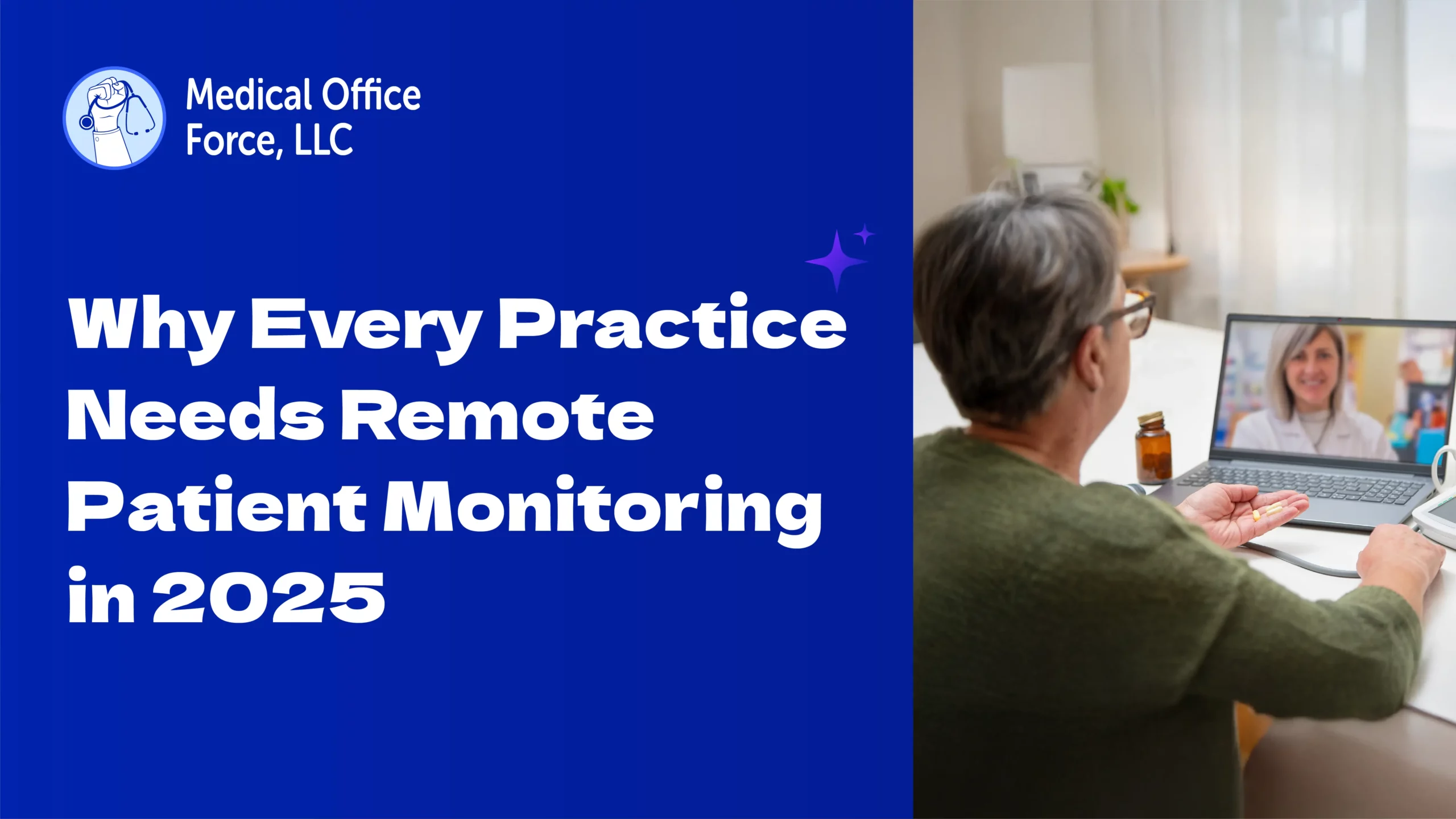
How RPM Is Reshaping Patient Care and Provider Revenue
In 2025, one thing is clear: healthcare is no longer confined to the four walls of a clinic. As technology evolves and patient needs become more complex, healthcare providers must find new ways to offer timely, effective, and efficient care. Remote Patient Monitoring (RPM) has emerged as a game-changing solution, not only improving patient outcomes but also helping providers stay compliant and profitable in a value-based care landscape.
At Medical Office Force, we specialize in helping clinics, group practices, and solo physicians integrate fully compliant RPM programs. With years of domain expertise and a deep understanding of Medicare billing, chronic care delivery, and digital health workflows, we are your go-to partner for scaling RPM with confidence.
Let’s dive into why every practice should prioritize Remote Patient Monitoring in 2025, and how we can help you do it right.
What Is Remote Patient Monitoring?
Remote Patient Monitoring (RPM) is the use of connected health technologies, such as blood pressure cuffs, pulse oximeters, glucometers, and weight scales, to collect patient health data from home or non-clinical environments. This data is securely transmitted to healthcare providers for real-time review, alerts, and interventions.
RPM is particularly useful for managing chronic conditions such as:
1. Hypertension
2. Diabetes
3. Congestive Heart Failure (CHF)
4. Chronic Obstructive Pulmonary Disease (COPD)
5. Obesity and post-surgical care
Unlike traditional care models that depend on occasional in-person visits, RPM creates a continuous loop of communication, where clinicians stay informed between appointments.
RPM in 2025: Why Every Practice Is Making the Move
1. Shift Toward Value-Based Care
Insurance payers and Medicare are pushing for better health outcomes rather than just more services. RPM aligns perfectly with this model by focusing on early detection, chronic care management, and preventive intervention.
According to the Centers for Medicare & Medicaid Services (CMS), value-based care models are expected to cover nearly 70% of patients by 2025.
2. Increasing Chronic Disease Burden
Over 6 in 10 Americans live with at least one chronic condition. Managing these conditions in-person alone is no longer sustainable. RPM enables providers to:
1. Spot trends in vitals over time
2. Modify treatment plans faster
3. Prevent ER visits and hospital readmissions
https://www.cdc.gov/chronic-disease/
How RPM Benefits Patients
For patients, Remote Patient Monitoring is more than a convenience; it’s peace of mind.
1. No Commute, No Waiting Rooms: Especially beneficial for elderly, rural, or mobility-challenged patients
2. Real-Time Monitoring: Enables early detection of deterioration
3. Higher Engagement: Patients become active participants in managing their health
4. Better Clinical Outcomes: Timely interventions lead to improved health markers and fewer complications
How RPM Helps Physicians and Clinics Thrive
Beyond better care delivery, RPM also improves practice profitability. Here’s how:
1. Reimbursable CPT Codes
RPM services are reimbursable under Medicare Part B. These CPT codes include:
1. 99453 – Device setup and patient education
2. 99454 – Monthly device data collection and transmission
3. 99457 – 20+ minutes of care management and interaction
4. 99458 – Each additional 20 minutes of care
Depending on the payer and region, RPM programs can generate $120–$180 per patient per month, on top of existing revenue streams.
2. Improved Quality Metrics
Insurance payers track performance through quality scores tied to:
1. Blood pressure control
2. Diabetes A1C levels
3. Medication adherence
4. Readmission rates
RPM boosts these metrics, helping providers stay eligible for bonus payments, incentive programs, and better payer contracts.
3. Enhanced Patient Retention
When patients feel supported beyond the clinic, they’re more likely to stay loyal to their provider. RPM fosters a stronger patient-provider relationship by delivering care where patients need it most, at home.
Why Insurance Companies Support RPM
Private payers and government programs like Medicare and Medicaid are strongly backing RPM programs because:
1. It’s cost-effective – Catching problems early reduces ER visits and costly hospital stays
2. It improves patient outcomes – Healthier patients mean fewer claims
3. It fits value-based care mandates – Continuous monitoring leads to better chronic disease management
Insurers reward providers who can demonstrate these improvements through metrics. RPM is a direct path to doing just that.
Why Partner with the Medical Office Force?
At Medical Office Force, we’re not just vendors; we’re RPM implementation experts who support your clinical and administrative teams from start to finish. Here’s how we help:
1. Compliant Device Setup (Medicare-approved & pre-configured)
2. Patient Onboarding & Education
3. Monthly Data Monitoring & Alerts
4. Clinical Escalation Protocols
5. Full-Service Billing & Documentation Support
6. CCM + RPM Integration for Maximum Reimbursement
You don’t need a large staff or extra infrastructure. We streamline everything for you.
Real-World Impact: Outcomes That Matter
Thousands of practices across the U.S. have adopted RPM with tremendous success. They’ve witnessed:
1. Higher patient satisfaction scores
2. Reduced staff burnout due to automation
3. More predictable revenue from chronic patients
4. Compliance with evolving CMS mandates
Whether you’re running a small private practice or a multi-specialty clinic, RPM allows you to scale your care without scaling your team.
Ready to Transform Your Practice?
The future of healthcare is here, and it’s remote, real-time, and patient-centered.
RPM is not a “nice-to-have”; it’s becoming a standard of care.
With Medical Office Force by your side, you can be confident that your RPM journey will be seamless, compliant, and financially rewarding.
Let’s Get Started Today
Contact Medical Office Force to schedule your RPM discovery call.
📞 +1 877-581-8810
🌐 www.medicalofficeforce.com
Let’s bring care closer to your patients, and success closer to your practice.


For more information, write to contact@medicalofficeforce.com
Share Your Thoughts
No comments yet — be the first to comment!